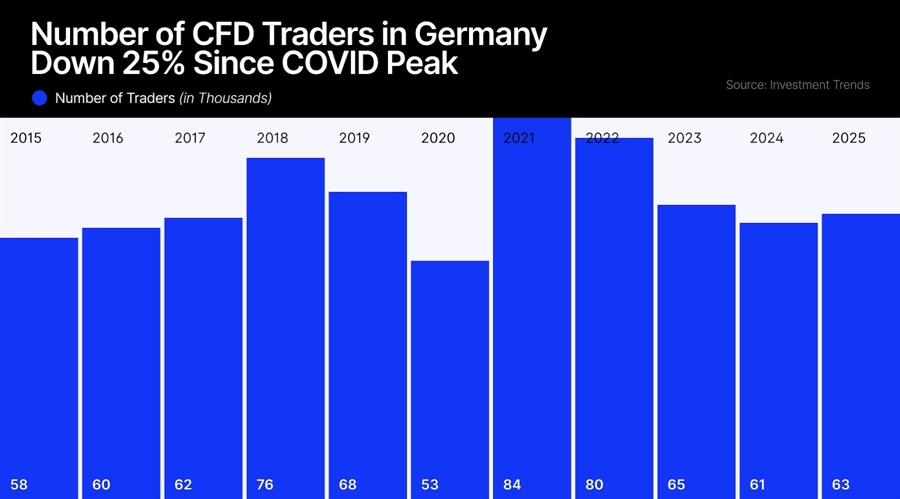Germany’s
leveraged trading market has reversed course, growing 3% to reach 63,000 active
CFD and forex traders in the 12 months to February 2025, according to a new
report from market research firm Investment Trends.
The
increase marks the first positive growth after three consecutive years of
contraction following the pandemic-driven peak in 2021.
The number
of traders in Germany’s CFD/FX market remains 25% below the COVID-era high of
84,000 recorded in March 2021, but the latest figures suggest the market may
finally be stabilizing after a prolonged adjustment period.
Lorenzo Vignati, Associate Research Director at Investment Trends
“This
marks an important turning point for Germany’s CFD/FX market,” said
Lorenzo Vignati, Associate Research Director at Investment Trends.
“The market has weathered a difficult period of contraction, but we’re now
seeing signs of sustainable recovery.”
However,
63,000 is still a relatively small number compared to
the 1.8 million active online investors in Germany, according to a separate
report by Investment Trends published in early April. The report also showed
that as many as 16% of respondents had changed or were in the process of
changing their broker.
The rebound
in FX/CFDs client base has been driven by a combination of factors, including
the reactivation of dormant traders and improved retention rates. The report,
based on a survey of 11,680 investors conducted between January and February
2025, revealed changing dynamics in how new participants enter the leveraged
trading market.
From ETFs to CFDs
While
shares and ETFs remain the primary gateway to trading for most Germans (72%),
the pathways are diversifying. Among new entrants to CFD/FX trading, 33% now
come with experience in listed derivatives and 27% arrive from cryptocurrency
markets – signaling an evolution in trader profiles and expectations.
“The
profile of the new leveraged trader in Germany is evolving,” Vignati
noted. “They’re arriving more informed, more product-aware, and with
different expectations of what a trading platform should deliver.”
The German
market’s recovery comes after a period of significant volatility. After
reaching a pandemic-driven peak of 84,000 traders in March 2021, the market
experienced three consecutive years of decline, with dormancy rates fluctuating
between 37% and 39%. This year’s positive growth suggests the market may have
found its footing after the extended correction period.
“Cross-Sell Appetite in
Germany Is Strong”
The report
also highlighted significant untapped potential for brokers to cross-sell
products. Despite 84% of German CFD/FX traders expressing openness to using
additional services from their main provider, only 26% of multi-asset traders
currently consolidate their trading and investing on a single platform.
This
disconnect points to a substantial opportunity for trading platforms that can
create more seamless experiences.
“Cross-sell
appetite in Germany is strong, but the experience gap is real,” said
Vignati. “To unlock value, providers need to build platforms that
genuinely integrate trading and investing.”
Moreover,
the German leveraged trading market has demonstrated resilience over the long
term, growing from 51,000 traders in April 2012 to the current 63,000 –
representing 23.5% growth over 13 years despite significant fluctuations along
the way.
Germany
vs. the Rest of the World
How does
the German CFD market compare to other major jurisdictions? In Hong Kong, around
100,000 individuals are engaged in trading such instruments.
Germany,
however, fares better
than Singapore, where only 38,000 people executed leveraged trades in 2024.
The popularity of the FX/CFD market is also declining in France,
where 29,000 people currently trade these instruments—down from a peak of
38,000 during the pandemic.
Germany’s
leveraged trading market has reversed course, growing 3% to reach 63,000 active
CFD and forex traders in the 12 months to February 2025, according to a new
report from market research firm Investment Trends.
The
increase marks the first positive growth after three consecutive years of
contraction following the pandemic-driven peak in 2021.
The number
of traders in Germany’s CFD/FX market remains 25% below the COVID-era high of
84,000 recorded in March 2021, but the latest figures suggest the market may
finally be stabilizing after a prolonged adjustment period.
Lorenzo Vignati, Associate Research Director at Investment Trends
“This
marks an important turning point for Germany’s CFD/FX market,” said
Lorenzo Vignati, Associate Research Director at Investment Trends.
“The market has weathered a difficult period of contraction, but we’re now
seeing signs of sustainable recovery.”
However,
63,000 is still a relatively small number compared to
the 1.8 million active online investors in Germany, according to a separate
report by Investment Trends published in early April. The report also showed
that as many as 16% of respondents had changed or were in the process of
changing their broker.
The rebound
in FX/CFDs client base has been driven by a combination of factors, including
the reactivation of dormant traders and improved retention rates. The report,
based on a survey of 11,680 investors conducted between January and February
2025, revealed changing dynamics in how new participants enter the leveraged
trading market.
From ETFs to CFDs
While
shares and ETFs remain the primary gateway to trading for most Germans (72%),
the pathways are diversifying. Among new entrants to CFD/FX trading, 33% now
come with experience in listed derivatives and 27% arrive from cryptocurrency
markets – signaling an evolution in trader profiles and expectations.
“The
profile of the new leveraged trader in Germany is evolving,” Vignati
noted. “They’re arriving more informed, more product-aware, and with
different expectations of what a trading platform should deliver.”
The German
market’s recovery comes after a period of significant volatility. After
reaching a pandemic-driven peak of 84,000 traders in March 2021, the market
experienced three consecutive years of decline, with dormancy rates fluctuating
between 37% and 39%. This year’s positive growth suggests the market may have
found its footing after the extended correction period.
“Cross-Sell Appetite in
Germany Is Strong”
The report
also highlighted significant untapped potential for brokers to cross-sell
products. Despite 84% of German CFD/FX traders expressing openness to using
additional services from their main provider, only 26% of multi-asset traders
currently consolidate their trading and investing on a single platform.
This
disconnect points to a substantial opportunity for trading platforms that can
create more seamless experiences.
“Cross-sell
appetite in Germany is strong, but the experience gap is real,” said
Vignati. “To unlock value, providers need to build platforms that
genuinely integrate trading and investing.”
Moreover,
the German leveraged trading market has demonstrated resilience over the long
term, growing from 51,000 traders in April 2012 to the current 63,000 –
representing 23.5% growth over 13 years despite significant fluctuations along
the way.
Germany
vs. the Rest of the World
How does
the German CFD market compare to other major jurisdictions? In Hong Kong, around
100,000 individuals are engaged in trading such instruments.
Germany,
however, fares better
than Singapore, where only 38,000 people executed leveraged trades in 2024.
The popularity of the FX/CFD market is also declining in France,
where 29,000 people currently trade these instruments—down from a peak of
38,000 during the pandemic.


